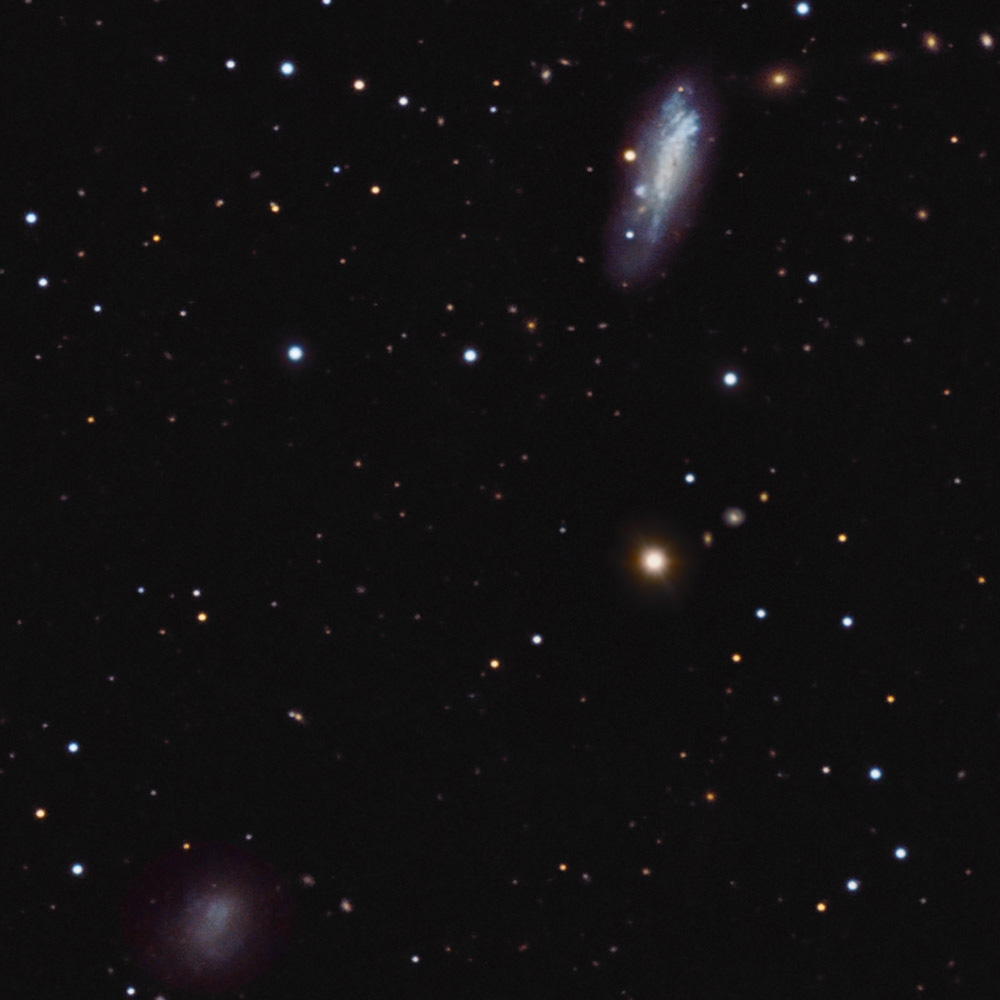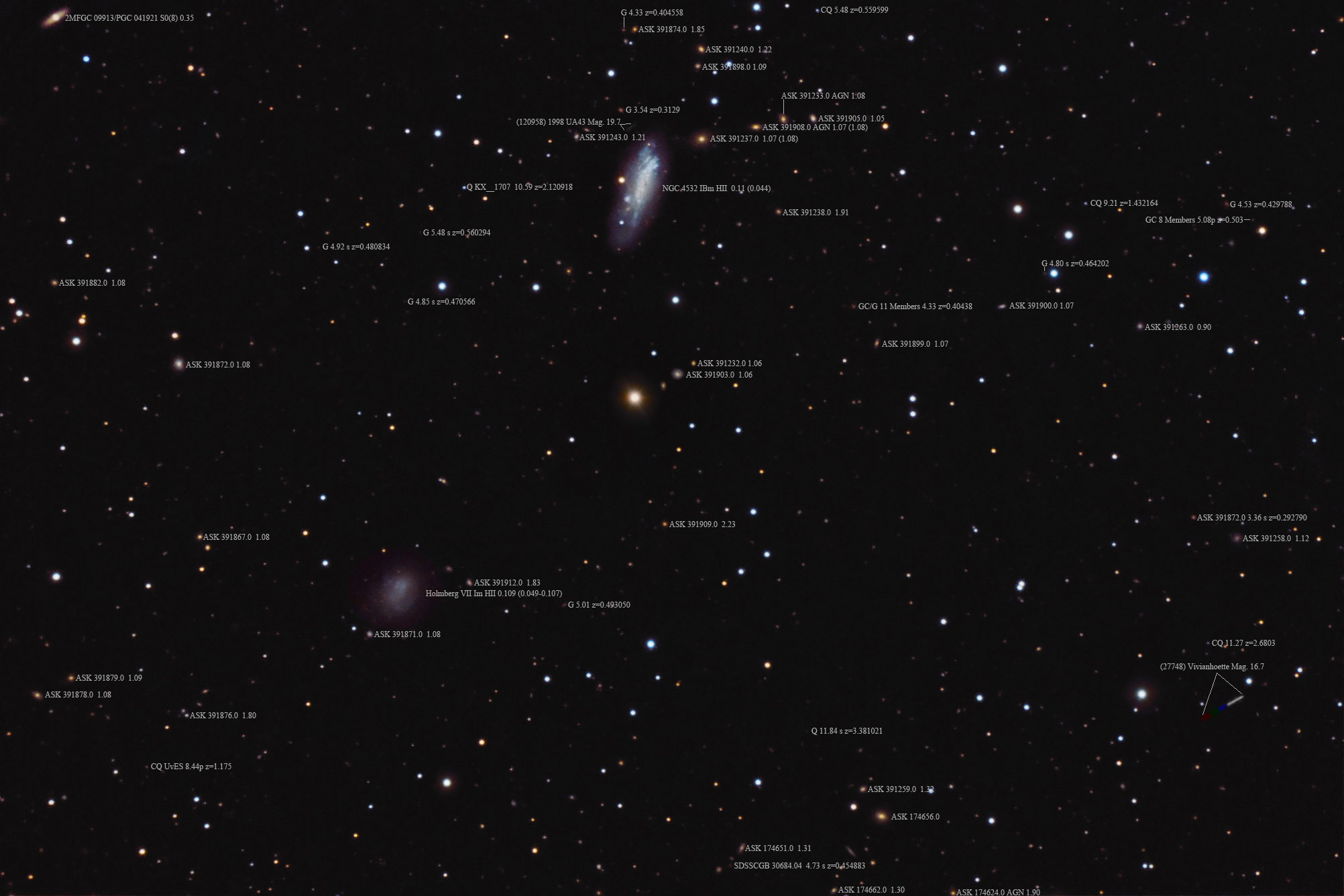| Description | Images |
Object name: HOLMBERGVIIDesignation(s): HOLMBERGVII, NGC4532, This is another twofer image. Both NGC 4532 and Holmberg VII were on my to-do list. If I'd not been around to override the system it would have taken two images centered on each galaxy. Fortunately, I caught it and saw I could put both into the same field saving me imaging time which with the cloudy weather we've had that is very hard to come by. SIMBAD classifies both as "Interacting Galaxies" But does this mean they are interacting with each other? SIMBAD is moot on that. As there's nothing else in this part of Virgo (the field is south of the center of the cluster) I assume that is what they are saying. The distance to this pair is also a bit vague. Redshift puts them almost 110,000,000 light-years distant. But most papers say these are members of the Virgo Cluster. If so they must be about 60 million light-years distant +/- about 20 million light-years. Non-redshift measurements of NGC 4532 put it 44 million light-years distant while Holmberg VII had only two such measurements, one put it about the same as the redshift distance while the other agrees rather well with the consensus for non-redshift distance measurements of NGC 4532. Most papers go with the non-redshift measurements as the redshifts of true Virgo clusters very widely. If the two are interacting and it's an ongoing interaction then the two might reasonably be expected to have similar redshifts right or wrong. Both are classified as irregular Magellanic type galaxies. If the redshift values are right they are 50,000 and 100,000 light-years in size. Large for this class of galaxy but not impossible. If the non-redshifts are correct then they are 20,000 and 40,000 light-years across. More typical of their class but this isn't definitive. The HST apparently hasn't taken these. It should be able to help answer this question if and when it does. Related Designation(s):2MASS J12341929+0628029, 2MASS J12341930+0628045, 2MASX J12341932+0628037, 87GB 123147.7+064419, 87GB[BWE91] 1231+0644, AKARI J1234188+062806, CGCG 042-158, CGCG 042-163, CGCG 1231.8+0645, CGCG 1232.2+0634, DDO 137, EVCC 0891, EVCC 0903, FAUST 3249, FAUST V113, GB6 J1234+0627, HDCE 0720 NED156, HIPASS J1234+06, Holmberg VII, HOLMBERGVII, IRAS 12317+0644, IRAS F12317+0644, LDCE 0904 NED184, LGG 296:[G93] 009, LGG 296:[G93] 012, MAPS-NGP O_556_0283707, MCG +01-32-103, MCG +01-32-107, NGC 4532, NGC4532, NSA 141654, NSA 162055, NVSS J123419+062808, PGC 041811, PGC 041861, SDSS J123418.74+062823.6, SDSS J123444.94+061759.6, UGC 07726, UGC 07739, USGC U490 NED106, USGC U490 NED115, UZC J123419.3+062808, UZC J123445.3+061802, VCC 1554, VCC 1581, WVFSCC J123426+062644, [BEC2010] HRS 203, [M98j] 174 NED161, [R83] 06deg038, [RC1] A1232, [RC2] A1232+06, [RHM2006] SFGs 130, [TCW2007] 126, | Permanent link: https://images.mantrapskies.com/catalog/OTHER/HOLMBERGVII-NGC4532/HOLMBERGVIIL4X10RGB2X10.JPG |


